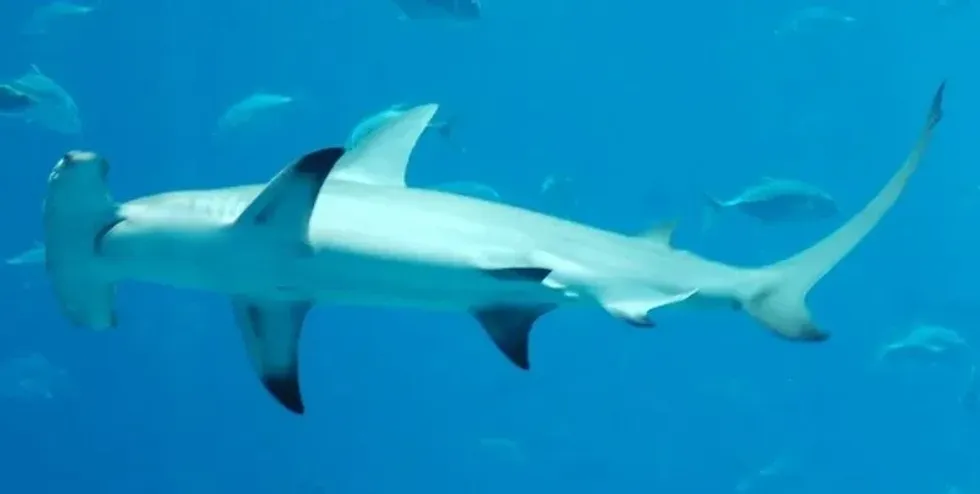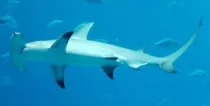Sharks are some of the various predatory cartilaginous fishes that comprise the order Selachii (class Chondrichthyes). The Great Hammerhead (Sphyrna mokarran) can be found in temperate and tropical waters all over the world, both offshore and close to shorelines, and are often seen in large numbers during summer migrations in search of cooler water.
Great Hammerheads draw their name from their hammer-shaped head. Great Hammerheads can be found in the Atlantic Ocean along continental shelves and island terraces.
Great Hammerheads rely on their large pectoral fins for swimming. Here are some interesting facts about Great Hammerhead Sharks and if you are interested, do check out these Caribbean reef shark facts and great white shark facts as well.
Great Hammerhead Shark Interesting Facts
What type of animal is a Great Hammerhead Shark?
The great Hammerhead Shark is one of ten shark species from the genera Sphyrna Euphyrna (one species) and Sphyrna (nine species), each with a shovel-shaped head or a flattened hammer, or cephalofoil. Hammerhead sharks, also known as sphyrnids, are among the most distinct and peculiar of all sharks.
What class of animal does a Great Hammerhead Shark belong to?
The Great Hammerhead Shark belongs to the Chondrichthyes class of animals. This is one of the largest sharks in this class of animals and they feed on a variety of prey including stingrays, squids, crabs, groupers, and sea catfishes. The first dorsal fin is very tall and falcate and is olive green in color.
How many Great Hammerhead Sharks are there in the world?
The Great Hammerhead Shark is the largest of the nine species of this shark. However, there is no estimation of how many Hammerheads exist in the world.
Where does a Great Hammerhead Shark live?
Great Hammerheads can be located deep in the ocean among other similar species where it searches for their prey. Due to its humongous size, this shark species is considered potentially dangerous for humans.
What is a Great Hammerhead Shark's habitat?
Great Hammerhead Sharks can be found in the open ocean as well as in deeper coastal waters. Over the summer, these semi-oceanic migratory species may make minor migrations northward.
Who does Great Hammerhead Shark live with?
The Great Hammerhead Shark lives in groups called schools. They are normally made up of 10-20 species.
How long does a Great Hammerhead Shark live?
Great Hammerhead Sharks have been recorded to live up to 44 years.
How do they reproduce?
The Great Hammerhead Shark is a viviparous species that engage in sexual mating. Maturity is achieved at a range of 10 ft (3 m).
Litters usually consist of 20-40 pups. Young are born in the summer and measure about 2.1 ft (0.6 m). A newborn puppy's head shape is more rounded than that of an adult, but this changes as they mature.
What is their conservation status?
The IUCN Red List classifies the Great Hammerhead as an endangered species. It is listed as endangered in the northwestern Atlantic and the Gulf of Mexico, where, despite being a non-targeted species, numbers have declined by half since the 1990s due to bycatch.
The species is critically endangered along Africa's western coast, where supplies have declined by an estimated 80% in the last 25 years. The Great Hammerhead's endangered status is primarily due to habitat loss and overfishing.
Great Hammerhead Shark Fun Facts
What does Great Hammerhead Shark look like?
The front part of the head of Great Hammerhead Sharks is smooth, with a deep central indentation. Great Hammerheads have high second dorsal fins and angled rear margins on their pelvic fins.
The teeth are triangular with extremely serrated edges that become increasingly angled toward the corners of the mouth. Their coloration ranges from deep olive green to brownish-grey on top and white on the bottom.
How cute are they?
Great Hammerhead Sharks are not bad-looking with a hammer-shaped head. But Great Hammerheads are still not cute because their faces are stretched out in the form of a hammer-shaped head.
How do they communicate?
Great Hammerhead Sharks interact with one another by pointing their fins down, shaking their heads, or ramming them with their snouts, much like the Smooth Hammerhead subspecies.
How big is a Great Hammerhead Shark?
The Great Hammerhead size is 600 times bigger than the world’s smallest shark, the dwarf Lantern Shark. The Great Hammerhead length range is around 20 ft (6 m). A great Hammerhead shark size comparison with the Great White Shark reveals that the Great White is bigger and heavier than the Great Hammerhead.
How fast can a Great Hammerhead Shark swim?
The Great Hammerhead Shark can reach speeds of up to 25 mph (40 kph). They are considered to be extremely athletic animals, capable of easily turning and twisting their limbs like the Smooth Hammerhead.
How much does a Great Hammerhead Shark weigh?
A Great Hammerhead Shark weighs around 900-1000 lb (408-453 kg). The Great Hammerhead is the largest Hammerhead species out of the nine known species of Hammerhead Sharks.
What are the male and female names of the species?
There is no specific name for the male and female Great Hammerhead Sharks. They are known as male Great Hammerheads and female Great Hammerheads respectively. This species of Hammerhead is amongst the largest fishes to be found along continental shelves, island terraces, as well as in deep waters.
What would you call a baby Great Hammerhead Shark?
Baby hammerhead sharks are called pups. They can also be referred to as juvenile Great Hammerheads.
What do they eat?
Invertebrates such as squid, crabs, and octopus are known to prey for the Great Hammerhead Shark, as are bony fishes such as sardines, tarpon, and others, as well as smaller sharks such as smoothhounds. They feed on a variety of prey including stingrays, squids, crabs, groupers, and sea catfish.
Are they dangerous?
The majority of hammerhead species are small and considered harmless to humans. However, the Great Hammerhead's immense size and ferocity make it potentially deadly, even though only a few Great Hammerhead shark attacks have been reported. But, Great Hammerhead shark behavior is quite aggressive, so it is best to stay clear of them.
Would they make a good pet?
Shark ownership is legal and can range from a few hundred to thousands of dollars. However, it is not recommended that sharks be housed in a tank or shallow aquarium. It is ideal to let this species remain in the natural Great Hammerhead Shark habitat, which is in tropical waters.
Did you know...
Great Hammerhead Sharks are thought to be cannibalistic, killing other animals if necessary.
The Great Hammerhead Shark is the largest of the nine species of hammerhead sharks.
Great Hammerhead Sharks have been discovered at depths of 984 ft (299 m), but Hammerheads prefer to survive in coastal waters up to 262 ft (79 m).
What is the native region of the Great Hammerhead Shark?
The Indian Ocean and the Indo-Pacific region, from the Ryukyu Islands to New Caledonia and French Polynesia, are native to Great Hammerhead Sharks. In the eastern Pacific, it extends from southern Baja California, California (US), across Mexico, and down to Peru.
When was the Great Hammerhead Shark introduced?
According to a recent analysis, the ancestor of today's hammerhead sharks first emerged in Earth's waters around 20 million years ago and developed over time into the diversity of these semi-oceanic fish of all shapes and sizes that swim the seas today.
Here at Kidadl, we have carefully created lots of interesting family-friendly animal facts for everyone to discover! For more relatable content, check out these basking shark facts, or frilled shark facts.
You can even occupy yourself at home by drawing one on our Hammerhead Shark coloring pages.










